In December last year, the International Labor Organization (ILO) reported that over 10 million Filipinos may experience job disruption in the way of salary cuts, decreased working hours, or total job loss because of the pandemic. In the Asia-Pacific region, approximately 81 million jobs were lost in 2020, which may raise the region’s unemployment rate by over 2% from 2019.
Given the job market’s volatility, workers should to be able to quickly adjust when faced with job disruption. With lessened pay and working hours, they need to find additional sources of income. With limited job openings, sudden unemployment might require, not only changing employers, but a career shift.
But how can one shift roles? For example, if you’ve been working in law for some time, and you wish to shift to being a writer, it pays to have soft or transferable skills that allow career mobility. Specialization or the mastery of one skill may increase your marketability, but only up to a certain point. With technological advancements and global crises such as the COVID-19 pandemic, your specialized skills run the risk of being outdated, which may lead to unemployment.

Hard Skills vs Soft Skills
While hard skills comprise technical knowledge or specific training for a particular area, Psychologist Roselle G. Teodosio, owner of IntegraVita Wellness Center, defines soft skills as “interpersonal skills that shape who you are, and how you work or deal with others.” Hard skills are more teachable, while soft skills are cultivated. Teodosio adds that hard skills can be thought of as IQ (intelligence quotient) while soft skills are equivalent to EQ (emotional intelligence). “Nowadays, a lot of companies look for people who have higher EQ. Emotional intelligence is seen as something that enhances and bolsters hard skills. A lack of soft skills would hinder an employee from thinking outside the box, or imparting their knowledge.”
In her two-decade career, Karen Seno has successfully shifted across roles in TV and video production, corporate communications, and human resources (HR). As the current HR manager of a holding company, Seno believes that soft skills are vital during these challenging times. “Soft skills are key in fostering an effective and productive virtual-work environment grounded on empathy. By developing soft skills, employees are able to add value both to their professional and their personal lives. It shows their commitment to self-development beyond the technical aspects of the job they hold.”
Teodosio agrees that soft skills show a person’s capacity to grow in a company. “Since employers tend to invest in their employees, they would want to have someone on a long-term basis. Companies also look for team players. A person who can adapt to different personalities, and shows good leadership and work ethic in times of crisis represents the company and what it stands for, especially to potential clients and business partners.” Such valuable soft skills also promote job security. “If there will be downsizing, economic slowdown or even a pandemic, then the employee who has shown these skills will likely be retained than let go,” Teodosio adds.
Though both hard and soft skills are necessary and complimentary to each other, Seno believes that that the latter trumps the former. “In most cases, I would say an ideal mix would be 60% soft skills and 40% hard skills.”

Top 5 Soft Skills Employers Seek
With the pandemic affecting businesses and employment, Teodosio says the need for soft skills is more relevant than ever. “Companies are very careful in choosing the employees that will be most beneficial to them in terms of productivity and flexibility at least cost. It is to the advantage of companies to retain employees who can play a lot of roles in the company to maintain productivity while cutting back on overhead expenses.”
But pandemic or not, employees need to step up their game to cope with the ever-changing landscape of industries. According to the World Economic Forum, the top 5 skills employers are looking for are also soft skills.
- Communication
Seno shares that shifting to a virtual work setup has limited our personal interactions, yet has increased the amount of time we spend on meetings. “Effective communication can then save on time and resources, bridge gaps, and establish stronger relationships.” Teodosio follows this up with by saying that clear communication should be carried out across all levels—“may it be the big bosses or their co-workers, one on one or as a team. Effective communicators build connections inside and outside the company.”
How to improve this skill:
- Be open to feedback.
- Constantly practice getting your message across.
- Be concise and get to the point.
- Be mindful of your non-verbal communication (body language, tone of voice, facial expressions).
- Be clear with your desired action from your listener or receiver.
- Problem Solving
Problem solving demonstrates a person’s self-reliance. Seno explains, “Companies need people who are concerned not just with delivering the basics according to their job description, but who can thrive when things don’t go their way.” Teodosio agrees. “A good employee is able to stay calm and rational when problems arise. Rather than emotions, his decisions are guided by logic and common sense.”
How to improve this skill:
- Learn to identify and simplify problems.
- Collaborate with stakeholders in brainstorming possible solutions.
- Be open to changes.
- Go beyond your comfort zone.
- Analytical Skills
Seno states that analytical skills are key in gaining an in-depth understanding of a topic or issue. “This is useful for goal-setting during project planning, or for coming up with solutions for complex problems.”
How to improve this skill:
- Learn all that you can about a topic or issue.
- Be observant.
- Ask questions.
- Interact with different personalities who offer various perspectives.
- Develop a learning mindset.
- Customer Service
Communication is the foundation of excellent customer service. Though this skill in useful in building a solid clientele, Seno stresses that “A good employee treats all their stakeholders—be they internal or external—as customers.” An openness to feedback and improvement ensures quality outcomes for customer satisfaction.
How to improve this skill:
- Manage customer expectations.
- Give services a personal touch.
- Focus on solutions to achieve customer satisfaction.
- Build positive relationships.
- Leadership
“Leadership requires accountability, authenticity, and empathy. Effective leaders are like lighthouses—they give a general direction for guidance as team members navigate the rough seas,” Seno illustrates. Teodosio says that “If an employee has good leadership skills, it follows that he is able to communicate himself well to others.”
How to improve this skill:
- Take the initiative.
- Listen.
- Develop situational awareness.
- Empower or motivate others.
- Encourage honest feedback.
While these traits have always been relevant in the workplace, Teodosio says they are even more important now during the pandemic. “The pandemic has brought on feelings of isolation and anxiety, to name a few. If one cannot handle such a stress, then how will he be able to address the other stressors work can bring?”
Tips for job hunters
Job hunting may be extra challenging these times, so our experts offer these bits of advice:
Widen your network. “Do not limit yourself to one or two fields,” says Teodosio. “Instead, try to look at other fields of expertise that you find interesting. It is not the best time to be picky.”
Boost your skills. Both experts agree that now is the perfect time to expand one’s knowledge. “Explore free online classes. The additional skills will make your CV shine,” advises Teodosio.
“Creating your own ‘personal brand’ will make companies notice you. You need to focus on what is unique about you.”
Prepare for virtual interviews. Because first impressions last, small details such as your clothes, background, and even the way you sit matter.
Be patient. If you don’t find a job right away, don’t be too hard on yourself. “A lot of companies are affected by the pandemic,” Teodosio says. “So, they are quite choosy with candidates. Just be on the lookout for job openings you are interested in.”
The pandemic’s global economic impact is undeniable. According to a World Bank publication last June, the world’s gross domestic product (GDP), which determines economic health, is forecast to contract by 5.2%. Meanwhile, the Asian Development Bank predicts the Philippine economy to shrink by 7.3% this year.
Filipino employees suffered, with 46% of them—equivalent to more than 27 million—losing their jobs during the pandemic, according to the Social Weather Stations (SWS) survey.
With people scrambling to survive and earn a living, we gathered wise words from a sector of society that used to get the short end of the financial stick, but through the years, have proven their monetary smarts—the women.
Pinay Financial Power
For centuries, women all over the world have been deprived of opportunities for education, political empowerment, health and economic development. But in recent years, Filipino women have been faring better. According to the World Economic Forum’s Global Gender Gap Reports in 2017, the Philippines was the only Asian nation and developing country included in the top 10 countries that promoted gender equality.
An article from the Alliance for Financial Inclusion considers culture as a driving force for female empowerment. In the Philippines, household budgets and finances are usually managed by the women. Interestingly, in 2012, the Philippine Statistics Authority reported that female-headed households enjoyed an income of 1.2% more than the households led by men, the former having annual savings of 3.2% more than the latter. In 2008, the Functional Literacy, Education and Mass Media Survey stated that financial literacy among Filipino women is higher (88.7%) than the men’s (84.2%).
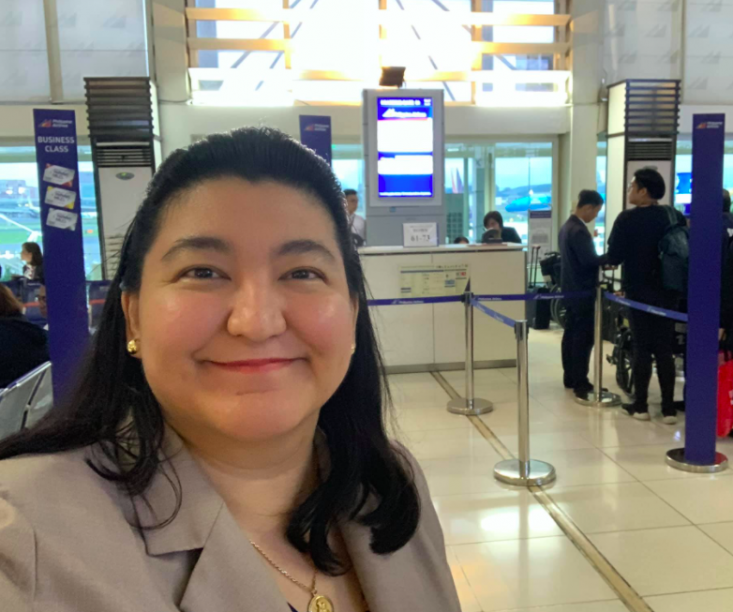 Deliza leaving for a business trip a year before the pandemic
Deliza leaving for a business trip a year before the pandemic
Hit by the Pandemic
Since 2004, Deliza Ridoloso has been managing a successful products-and-services business that caters to the banking industry. “Before COVID-19, we were reaching the height of our consolidated revenues,” she shares. “When ECQ [enhanced community quarantine] hit, we lost 85% of our revenues. At least we had 15% left; it was better than nothing. But getting that 15% was a lot of hard work.”
For Lala Javier-Rosales, mother of two, the pandemic was a wake-up call. As the one in charge of dispatching foreign volunteers for a Japanese governmental agency that provides assistance in the Philippines, she feared for her job. “Since all the volunteers were recalled because of the pandemic, I thought my employers would let me go. But the agency’s president assured us that we would keep our jobs.” Though she was retained, Lala realized that nothing was ever really certain. “Before, I felt so secure in my job. I earned decent pay, and I was planning to rely on my work until I retired. But now, I realize that I need to be prepared for unplanned situations.”
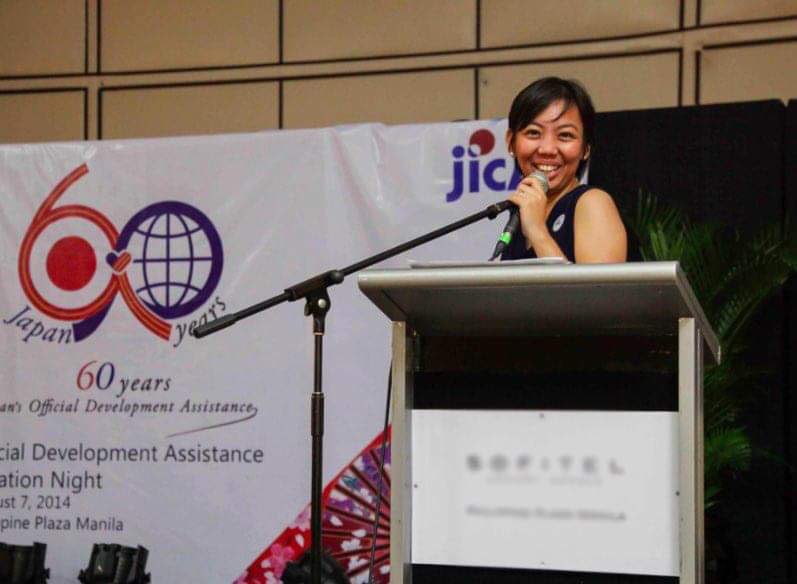 Lala hosting a company event
Lala hosting a company event
Rapid Adjustment
Deliza’s company managed to continue operations despite the changing quarantine categories in Metro Manila. This, Deliza attributes to their business continuity plan, which the management team began back in 2008. “Our business continuity plan was for earthquakes and floods, and not really a pandemic. But because we were already getting news of the virus in January, and started hearing of lockdowns in other countries, we started tweaking our plan.”
Deliza admits that back then, they didn’t know that a pandemic was about to happen. Still, they held emergency meetings twice a week to prepare for the virus in case it hit Manila. “For more than a decade, we’ve been saving documents in cloud storage and an off-site server. What we prepared for at that time was for disasters like earthquakes and fires. But the plan was also applicable when ECQ was declared and we couldn’t get to the office.” The plan also included protocol for people working from home, and health monitoring. “From the beginning, we already made our own health checklist based on information from WHO (World Health Organization).
Because Deliza’s company offers business-to-business products, they beefed up their remote marketing strategy. “This was where our 15% revenues came from. We had to adapt right away. We did video conferencing. Because we couldn’t meet face-to-face with our clients, we had our presentations on Zoom. We worked on our digital marketing to make sure our presentations were clear. Communication was important— with our clients, our staff, our suppliers.” Her management team met as often as twice a day via Zoom. “The situation kept on changing at the end of the day. When I think about it now, it sounds a little excessive? But it wasn’t because we were working so hard to continue operations remotely. We had to re-engineer our processes.”
At the start of the lockdown, working from home allowed Lala to re-assess her family’s finances. “I had time to reflect. Before the pandemic, I had an essential oils business that I wasn’t really taking seriously. From time to time, I’d share about it on my Facebook page, but I wasn’t conscientious about it.” Since the pandemic, Lala has become more vocal and intentional about her business. “I truly love essential oils, and the more I shared about it, more people signed up under me until my business grew. It came to a point where I started earning more from it than from my day job.”
Another earning opportunity came to Lala because of her love for food. “Food is my stress-reliever. And because me and my husband hail from Batangas, we found ourselves missing the delicacies there.” When the couple secured a travel pass, Lala offered to buy Batangas delicacies for her interested friends. “I’d post the announcement and food photos on my Facebook wall. That side business augmented our family income. It was a great feeling to make other people happy through food.”
 Deliza (2nd from right) with university students
Deliza (2nd from right) with university students
Present Scenario
Up until June, Deliza’s company managed to keep all their approximately 100 employees. But eventually, some were let go. “We tried to give them the best arrangement we could afford. We allowed them to use up their sick and vacation leaves so they’d still get paid. One of our managers who was a senior citizen got the retirement package, which we give in monthly installments.”
Revenues have picked up in September, but Deliza says cash flow continues to be tight. To keep other employees, their work hours were cut down, along with their pay. “At the end of the year, we aim to break even at the minimum. We’re trying our best to keep all our people and not have any more layoffs. So we’re trying to keep costs covered while operating as best as we can.”
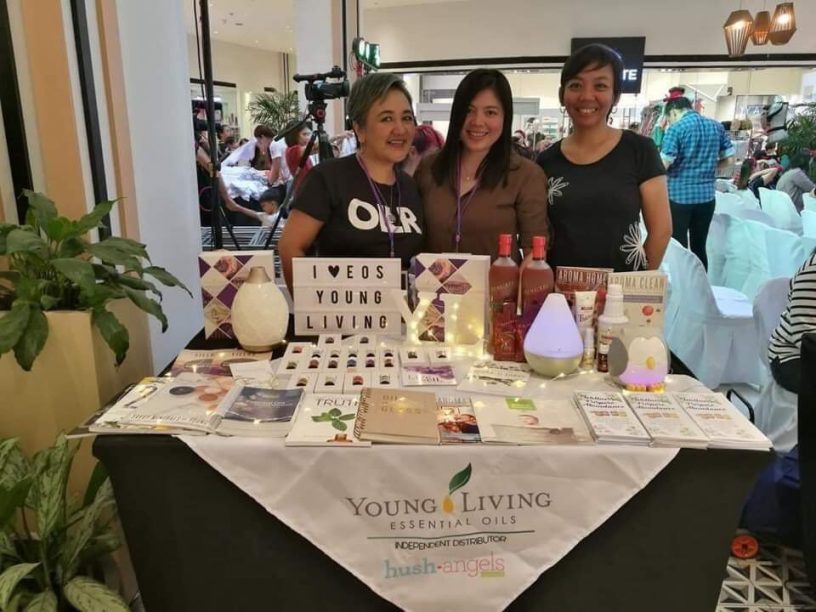 Lala (right) and her essential oil business
Lala (right) and her essential oil business
Financial Survival Tips
Survival depends hugely on preparedness. Deliza and Lala share the insights they have gathered during the pandemic.
Be informed. “Being aware of global current events gave us an idea of what’s going to happen in case Manila was put under lockdown. Being on top of the news is very important,” says Deliza. “We were being observant, and prepared in our own way.”
Never be complacent. Because of the pandemic, Lala learned that it’s vital to have multiple income streams. “Aside from side businesses, my husband has also become more involved in their Batangas farm. We want to grow our own food, and maybe eventually, earn from it.” In choosing side businesses, Lala advises to “find something you’re passionate about. Turn your passion and talent into something income-generating.”
Work on a business continuity plan. “I believe that every business should have a continuity plan in case of emergencies,” says Deliza. “It’s a lot of work because it has to tailor-fit your operations. It’s not a template you can pull out a book; you have to make it your own. Every year, we refine our business continuity plan.”
Maintain a good relationship with banks. “We have bank loans, and luckily, we’re able to meet our responsibilities with them. If you can’t pay them, then you shouldn’t run. You need to talk to the banks, and discuss what you can do.” Deliza also shares her company’s golden rule: Don’t borrow money for something consumable. “We make loans to make purchases for our goods we plan to sell, not those we already sold. We borrow money to make money, so we can pay back our loans.
Set goals. Outlining goals is also a sign of preparedness. “Our team talks about our financial goals, about what we need to target to keep as many people as we can, and keep the company healthy.” Lala’s latest goal is to secure a critical-health insurance for her family. “My father-in-law was recently hospitalized and he shelled out a huge amount of money. If that were to happen to my family, I wouldn’t know where to get the cash.”
Gain support. While Lala’s network of friends was instrumental in growing her side businesses promoted through social media, Deliza finds that being part of a business organization helped validate her company’s steps in surviving the pandemic. “Being part of a business group helped boost my confidence and knowledge on how we should do things. It gave me a better understanding of best practices.”
The pandemic may be far from over, but these women will continue to do their best to weather the financial storm. “I have no plans of resigning, and I aim to further grow my businesses,” Lala declares. Deliza stresses the importance of taking the time to prepare for possible outcomes. “If you’re leading your company, you should have a clear vision. You need to go to a quiet place and meditate and think about scenarios. You really need to adapt if you want your business to survive.”
Australia is currently on its second wave of Coronavirus Disease (COVID-19) infection. The first COVID-19 case in Australia was reported on January 25, 2020. The number of cases in the country sharply rose in March, then declined significantly in April due to lockdowns and strict health protocols. In July, Australia saw another increase in COVID-19 cases in Melbourne, the capital of the state of Victoria. Victoria is under lockdown as of writing. However, other states like New South Wales whose capital is Sydney, are under milder restrictions. Australia is the fifth country in the world with the largest number of overseas Filipino workers. Let us take a look at the day-to-day experiences of a Filipina living in Sydney on Buhay Pandemya.
While growing up, Filipino children get acquainted with animals such as giraffes, bears, rabbits and lions. But rarely do they know indigenous flora and fauna like the Philippine Eagle, tamaraw, musang and rafflesia. To bridge this gap, Anya Santos-Uy, who used to work at the Haribon Foundation, wrote and published an alphabet book, which highlights our local species. Watch the video to learn more about her children’s book.
At 4 p.m. today, the Department of Health (DOH) reported 5,277 new COVID-19 cases, bringing the total number of infections to 202,361 in the country. Of these newly-reported cases, 82% or 4,350 were chronicled between August 13 and August 26.
TOP PLACES WITH NEWLY-REPORTED CASES
The National Capital Region (NCR), being the epicenter of COVID-19 outbreak in the country, tops the list with 3,157 new cases followed by Laguna (403), Negros Occidental (304), Rizal (237), and Cavite (228).
DOH saw a relative increase of local transmission in Negros Occidental, which made it to the list of top places with newly-reported cases for 2 consecutive days.
ACTIVE CASES, RECOVERIES, AND DEATHS
With DOH’s mass recovery scheme, the country’s number of recoveries breached the 100,000 mark.
Today, 1,131 new patients have recovered, while 99 have died, bringing the total to 133,460 recovered patients and 3,137 deaths. Meanwhile, DOH’s data showed that there are 65,764 active cases in the country.
DOH added that 80 duplicates were removed from the previous total case count. Of these, 58 recovered cases have been removed as the numbers underwent validation.
CASE FATALITY RATE, CASE DOUBLING TIME, AND NUMBER OF TESTS
Despite the evident increase in the number of cases, DOH remained firm in its stand that the country is handling the pandemic well.
In its latest bulletin, DOH highlighted the cases fatality rate – defined as the proportion of people who died from COVID-19 among individuals diagnosed with the disease – as faring better at 1.55% compared to the global case fatality rate of 3.37%.
With the case doubling time or the number of days it takes for cases to double, the country is said to be faring better with 9.97 days compared to the 1.55 days back March 15, 2020, which marked the start of the Luzon-wide Enhanced Community Quarantine (ECQ).
To date, a total of 2,245,872 individuals have been tested.
International Summit Council for Peace
World Leaders to Address “Rally of Hope”
August 9, 2020, at 8:40 AM (Manila time)
PRESS RELEASE
Despite material advances and the amassing of unprecedented wealth, serious global problems remain unsolved. This is all the more striking when it is seen alongside worldwide efforts to maintain peace, resolve conflicts and end poverty by major international peace-keeping bodies, public and private.
Territorial disputes, religious and racial discord, the collapse of family values, and an aggregate of environmental issues are flaring up on all continents. Added to this is the COVID-19 pandemic which has caused catastrophic economic debt. It seems like a perfect storm.
Just such dilemmas drew the late Rev. Dr. Sun Myung Moon and his wife Dr. Hak Ja Han Moon to speak out for the realization of an ideal world. Their vision: one human family bound together by the love of God. For decades, they have advocated the philosophy of interdependence, mutual prosperity, and universal values which challenges us with the novel concept of seeing our own purpose in life fulfilled in the well-being of others.
To emphasize these values and help address related problems, the Universal Peace Federation (an NGO in general consultative status with the Economic and Social Council of the United Nations), will be hosting the latest in a series of on-line virtual summits. The Rally of Hope will be held August 9, 2020 beginning at 8:40 AM (Manila time). The official theme is, “One Million Rally of Hope for the Realization of a Heavenly Unified World of Interdependence, Mutual Prosperity, and Universal Values.”
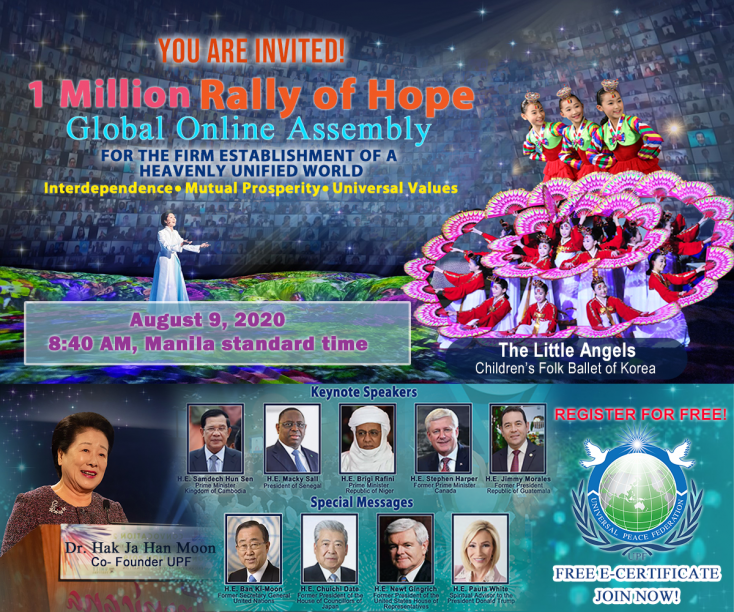
Ban Ki-moon, former UN Secretary-General and Chairman of the National Council on Climate and Air Quality in Korea, will give the welcome address. Following this, Rev. Paula White, spiritual advisor to President Donald Trump, will give her special remarks. Congratulatory messages from the Hon. Chuichi Date, former President of the House of Councillors of Japan, and the Hon. Newt Gingrich, former speaker of the United States House of Representatives will follow.
Interspersed with first-class entertainment, keynote addresses will be given by H.E. Hun Sen, Prime Minister of Cambodia; H.E. Macky Sall, President of Senegal; the Hon. Brigi Rafini, Prime Minister of Niger; H.E. Dick Cheney, former Vice-President of the United States of America; and other world leaders. Finally, Dr. Hak Ja Han Moon, co-founder of the Universal Peace Federation and host of the Rally, will give her keynote address.
E-certificates will be available upon request. In addition, all participants will have a chance to learn more about the Universal Peace Federation and its worldwide movement.
To register for the Rally of Hope visit http://www.upfasia.org/rallyofhope-register.
UPF is an NGO in General Consultative Status with the Economic and Social Council of the United Nations 32 Samar Avenue, Brgy. South Triangle, Diliman, Quezon City Telephone number: (63)(2)924 1833 Website: www.upf.org Email: upfphils.pr@gmail.com
Time flies when you’re having fun, and seems to slow down when you’re in a less desirable situation. But time is more than the numbers glowing on our phones and watches; it is a fascinating ode to astronomy.
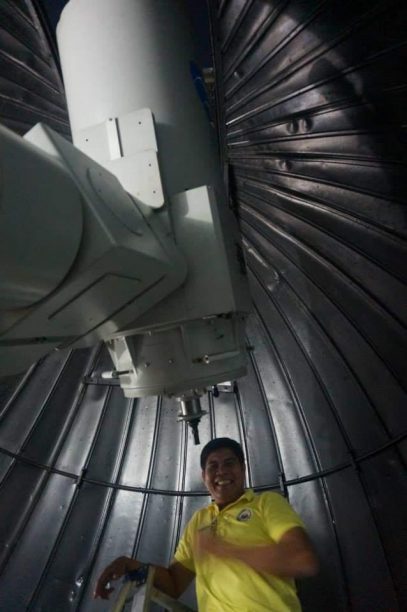 Raymundo with a 45-cm GOTO Telescope, the largest optimal telescope in the country, at the PAGASA Astronomical Observatory in the University of the Philippines.
Raymundo with a 45-cm GOTO Telescope, the largest optimal telescope in the country, at the PAGASA Astronomical Observatory in the University of the Philippines.
When Electrical Engineer Mario Raymundo first entered the Philippine Atmospheric, Geophysical and Astronomical Services Administration (PAGASA) office in 1993, he was assigned to the weather’s bureau’s time service unit. Here, he learned how time could be measured by observing the movement of celestial bodies, and how time zones in different parts of the world are based on the fact that it takes the Earth one hour to turn 15 degrees.
As time went by, it seemed almost natural for Raymundo to gradually expand his knowledge and duties to include astronomy. “As an engineer, I was well-versed in mathematics, including trigonometry. But in astronomy, I learned spherical trigonometry to make observations on the celestial bodies.”
Decades later, Raymundo is now chief of the PAGASA Astronomical Observation and Time Service Unit. “We use a 45-centimeter telescope to observe variable stars. During the daytime, we study and photograph sun spots.” Sun spots or dark spots that appear on the Sun’s photosphere may have an effect on the Earth’s weather patterns. Meanwhile, variable stars or stars that change their brightness are studied to possibly discover other stars and signs of life in the galaxy.
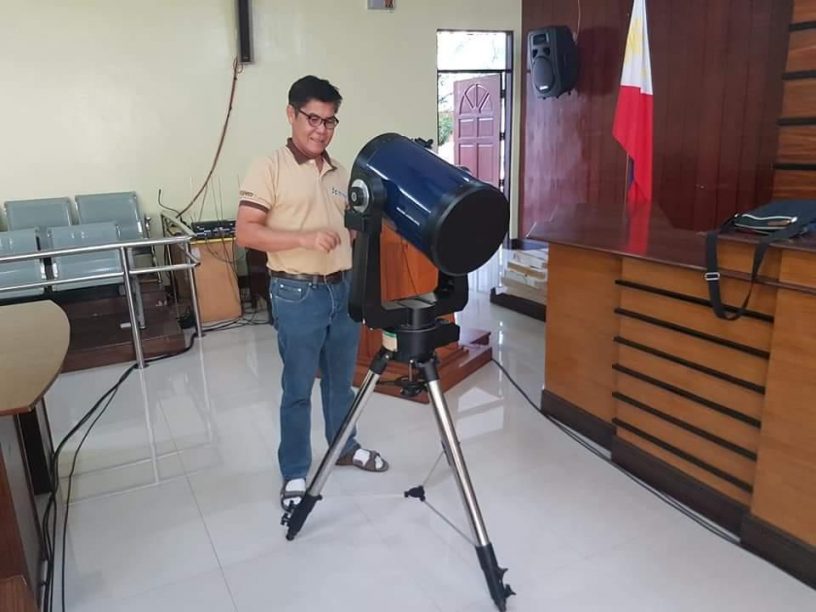 Raymundo with a compound telescope
Raymundo with a compound telescope
Astronomy for Filipinos
Raymundo admits that the study of astronomy in the Philippines is limited because of the lack of funding for high-cost equipment. “Astronomy equipment is very expensive. A 1-meter telescope alone costs a million (US) dollars, which is roughly 50 million pesos. You can feed a lot of Filipinos with that amount.” Still, Raymundo believes that PAGASA provides a good foundation for future Filipino astronomers. “We have to start somewhere to impart the knowledge to future generations. Before the pandemic, we regularly visited schools with our mobile planetarium to conduct lectures.”
Despite the challenges, Raymundo says astronomy remains significant for Filipinos. “A lot of Filipinos are hungry for astronomical knowledge. In science textbooks in schools, only 7 to 8 pages are dedicated to astronomy, offering only general facts. When we conduct lectures, we give students direct knowledge. Through the planetarium, they better understand why celestial bodies are positioned in certain ways, and the importance of the Polaris or North Star. It’s easier to explain things that way.”
 Annular Solar Eclipse in December 2019 in Balut Island in Saranggani, Davao Occidental
Annular Solar Eclipse in December 2019 in Balut Island in Saranggani, Davao Occidental
 Training in Spain on Astronomical Observation which lasted for several months
Training in Spain on Astronomical Observation which lasted for several months
Astronomy saves lives
But astronomy is not only a passive observation of the skies; it can also save lives. In 2013, an asteroid about the size of a six-story building blasted over Chelyabinsk in Russia. Its explosion generated a shock wave that shattered glass and injured over a thousand people. “Outer space can bring disasters,” Raymundo says. “In reality, thousands of meteors enter our planet, but they usually disintegrate before hitting our surface. The one that exploded in Russia was unexpected, so we need people to be aware that this kind of disaster is possible.”
On July 15, Panahon TV will host a free webinar called Understanding Space with Raymundo as the speaker. “I’m excited because it’s my first time to conduct an online lecture. It’s a different approach and I’m looking forward to the results.” When asked what he’s excited to share with the webinar participants, Raymundo says, “I hope to better explain to them the things they read in books. Everything from the constellations to the zodiac, I will be able to describe in detail.”
Catch Chief of PAGASA Astronomical Observation and Time Service Unit Mario Raymundo in Panahon TV’s free webinar, Understanding Space, on July 15, 2020 at 2 pm. To register, click here: https://bit.ly/2Z7TJa4
After the Quadrantids Meteor Shower last January 4, the skies will once again be illuminated by another major astronomical event—the Penumbral Lunar Eclipse.
Eclipses come in pairs
A solar eclipse is always paired with a lunar eclipse. A solar eclipse only happens during the new moon, while a lunar eclipse occurs during the full moon. For an eclipse to occur, the new and full moons have to take place within the eclipse season, wherein the Earth, Sun, and Moon are perfectly aligned. This happens twice a year, about six months apart.
What is a Penumbral Lunar Eclipse?
On January 11, 2020 at 1:07 a.m., the Penumbral Lunar Eclipse will be visible in the country. It occurs whenever the Earth passes between the Moon and the Sun, blocking out sunlight and casting a shadow on the Moon’s surface.
Unlike other types of eclipses, a Penumbral Lunar Eclipse is more subtle and much more difficult to observe. According to Fred Espenak, an American Astrophysicist, about 35% of all eclipses are penumbral. Another 30% are partial eclipses, while the remaining 35% are total eclipses of the moon.
Where will the Penumbral Eclipse be visible?
The eclipse will be visible in Africa, Oceania, Asia, Europe, and Northern America.
In Manila, the Penumbral Lunar Eclipse starts at 1:07 a.m., reaching its peak at 3:11 a.m. and ending at 5:12 a.m. The next eclipse for the year will be visible on June 6.
Can We Live on Mars?
Can other planets supporting life? Are we alone in this vast universe? These are some of the questions curious minds are interested in. And it’s this intense kind of curiosity that has led to one of our most ambitious space projects, the Mars Exploration.
Meet Mars
Mars is sometimes called the “Red Planet”. It’s red because its surface has iron oxide or rusty particles. Its only half size of Earth and like our planet, Mars has volcanoes, weather, seasons, polar ice caps and canyons. Its thin atmosphere is made of nitrogen, argon and carbon dioxide. These characteristics encouraged scientist to dig deeper into Mars’s history to find out if it once supported life – and maybe able to in the future.
The Mars Mission
So far, almost 50 spacecraft have visited Mars, but not all of them were successful in landing on its surface or in orbiting around the planet. Mars is the only planet scientists have sent rovers to –. These vehicles drive around the planet to take photos and measurements.
Scientists begun to send probes to the red planet in 1960. But Mars Exploration Program funded and led by the National Aeronautics and Space Administration (NASA), officially begun in 1994. The first six spacecraft all failed to reach Mars orbit.

Courtesy: NASA
Mariner 4 was the first successful flyby attempt that entered the planet’s orbit, arriving on July 14, 1965. This mission provided the first close up images of the planet.
The most recent successful landing on Mars happened just last November 2018. The Interior Exploration using Seismic Investigations, Geodesy and Heat Transport (InSight), is a robotic lander designed to study the deep interior of the planet and to listen to Marsquakes.
The Possibilities of Mars
Scientist are exploring Mars to determine if life ever arose on Mars, to characterize its climate and geology; and ultimately, to prepare for the human exploration of Mars. The Mars Exploration Program is a science driven program that seeks to understand whether Mars was, is, or can be, a habitable world.

Courtesy: NASA
Terraforming is the primary ingredient of the concept of Mars – colonization. This is a speculative course of alteration of the conditions of the planet to make it habitable for lives that are existing on Earth without any life supporting system.
In order to make Mars a habitable planet, Bruce Jakosky, a planetary scientist and principal investigator for NASA’s Atmosphere and Volatile Evolution and Christopher Edwards an assistant professor for planetary science, said that by using greenhouse gases that already present on Mars, we could, theoretically, raise temperature and change the atmosphere enough to make Mars an Earth – like.
Mars has exactly opposite problem as Earth. Mars as we all know is a cold planet, in fact the current climate on Mars is at average of about minus 81 degrees Fahrenheit (– 62.78°C), though the temperature can vary wildly. That is why scientists want to make Mars hotter and thicken its atmosphere, so its polar ice caps can melt. Considering more water means more opportunities for microbial life to do its work.
The idea of using microbes to begin a terraforming project on Mars is so encouraging that NASA has already begun initial tests. The Mars Ecopoiesis Test Bed is proposed for development to be included with future robotic mission to Mars. This is something look like a drill with hollow chamber inside with container full of cyanobacteria. The drill would bury itself in the Martian soil, preferably in a place with the presence of liquid water and then the container with cyanobacteria would be release into the chamber and the built – in biosensor would detect whether the microbial life produce any oxygen or other bvproducts.
The first phase of this project was conducted in a simulated Martian environment here on Earth, and the results were promising. But even still, there are some major challenges we’ll have to face if ever we want to use microbially terraform Mars on a large-scale.
Conclusion
We are clearly excited about what the future may bring. Pushing ahead, trying to understand what Mars may have for us. Uncertain of what the outcome may be, but McKay once said, “Life may not be scientifically preferred explanation, but it cannot be yet disproven”.
By: May Dacula, PanahonTV Intern
Sources:
https://history.nasa.gov/marschro.htm
https://science.nasa.gov/solar-system/programs/mars-exploration
https://bigthink.com/surprising-science/using-bacteria-to-terraform-mars
